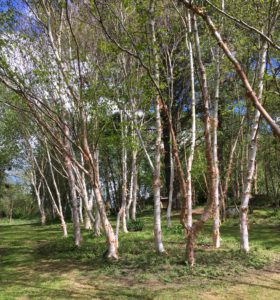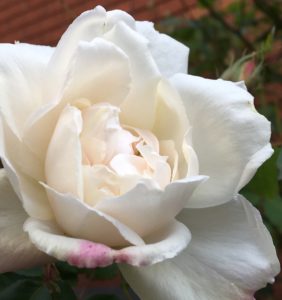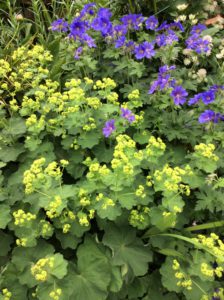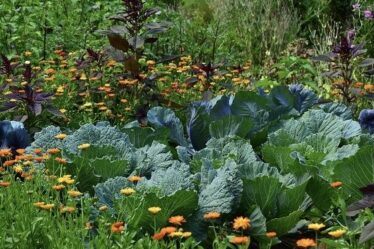
Plants That Grow Well In Clay Soil
Not all clay soil properties are bad. Let’s first change this common mind-set that nothing grows in it. There are many lovely plants that grow well in clay soil, in fact they positively thrive in it.
What Is Clay Soil?
Clay soil has a very fine structure with small particles which means that water or air cannot get through it easily, this causes bad drainage, the soil becomes heavy and difficult to work.
Water-logging can be a real problem which will slow the growth of plants and potentially rots the roots of plants.
Clay soils take longer to warm up ready for planting and are harder to dig but the benefits of clay soils are that they are full of nutrients, they retain moisture and are extremely fertile. More so than some other soils, so if you have clay you can use these facts to the mutual benefit of your plants and your health and well-being by creating a beautiful garden full of colour, life and year round interest within your outdoor space.
Plants That Grow Well In Clay Soil
Trees for Clay Soil
UK Native trees are suited to our clay soils but alas, we don’t all have space for a mighty oak tree or chestnut tree for example but most gardens can accommodate some trees, there are some wonderful varieties that can be incorporated into any kind of design or planting scheme.
- Birch
- Eucalyptus
- Japanese Maple
- Liquidamber
- Hawthorn
- Magnolia
- Amelanchier
- Sorbus
- Fruit trees (most of the cider apple orchards in Somerset are clay soil.)


Shrubs for Clay Soil
Once established these shrubs are well suited to clay soil and with some care and attention such as feed, seasonal pruning and shaping they will provide lots of shape and all year round interest.
Choose some evergreens and wildlife friendly shrubs with berries to give seasonal interest as well as food and habitat for birds and wildlife.
- Cornus
- Viburnum
- Mahonia
- Berberis
- Pyracantha
- Cotoneaster
Many of these plants have evergreen leaves or colourful berries too which add to their interest and value as the backbone plants in your garden.


There are some beautiful hardy flowering shrubs that you can grow in clay soil too, such as
- Weigela
- Buddleja
- Forsythia
- Hydrangea
- Chaenomeles
These are all gorgeous shrubs that will add colour, form and fragrance to your garden.
Roses are very easily grown in clay soils, especially if you make the effort to improve the soil with plenty of organic matter. Roses will happily grow and flourish. Their roots are held better in clay soils therefore they don’t get wind rock which can be damaging to them. Plant roses in a sunny part of the garden. They will not do so well in shade as there will not be sufficient sun to help dry the ground.

Roses will suffer if the roots become waterlogged, although some roses including the rugosa group are tolerant of wet soils.
Perennial Plants for Clay Soils
There are also plenty of perennial plants that are suitable too whether you are looking for plants for shade, sun or both, you can grow lovely flowering perennials for the borders and have some colour and foliage to light up those shade areas as well.


Shade
- Japanese Anemone
- Ajuga
- Hostas
- Vinca
Sun or Sun and partial shade
- Astrantia
- Astilbe
- Kniphofia
- Hardy geranium
- Alchemilla Mollis

Climbers
For me a garden is not a garden without some climbing plants to add texture, form and height or to disguise fences and buildings. If you feel the same way too then you will be relieved to know that you can choose some climbers that will live happily in a clay garden.
- Clematis
- Roses
- Honeysuckle
- Ivy
Clay Soil In The Vegetable Garden
Vegetables
Main crop vegetables do well in clay soil as they are planted later in the season when the soil is warm and drier.
Due to the high nutrition content in clay soil and water retention crops such as:
- Cabbage
- Pumpkins
- Squash
- Leeks
- Onions
- Broccoli
- Sprouts
will all thrive in and generally have higher yields.
Vegetables with big roots like the broccoli and sprouts do better as the soil holds the roots more solidly.
Another way of preparing clay soil planting areas for growing vegetables is to incorporate a no dig raised bed with good deep layers of organic matter and compost, then vegetables such as carrots and parsnips will establish strong roots that will work down into the clay soil beneath.
Tips And Tricks For Dealing With Clay Soil
Dig in Autumn or Winter when they are relatively dry if we have had a warm dry summer. If clay soil does become too wet it often can not be dug until Spring.
Dig into furrows to allow for more frost to help to break it down, it also improves drainage.
Do not plant too early as the soil is too wet and cold for plants to establish healthily.
Do not walk over clay soil when it is wet, this cause compaction and makes it a lot harder to work.
Plant trees and shrubs on a small mound to help improve drainage around the roots.
RHS Gardens
The RHS have two gardens on clay soils, both of which are very different from each other.
RHS Rosemoor in Devon also has to contend with the added problem of high rainfall, thereby drainage can become a problem.
RHS Hyde Hall has heavy clay soil but less rainfall than in Devon, resulting in two very different gardens that require careful management and planting.
Both are stunning gardens that look beautiful all year round with a huge variety of trees, shrubs, plants and bulbs.
The hard work of the teams of gardeners, horticulturalists and experts, knowledgeable about the areas they work and garden in is clearly evident. They truly are an inspiration for anyone who has a clay soil garden.
How To Improve Clay Soil
On a new garden or allotment work in sections… there really is no need to labour over the whole garden all at once. Dig in lots of organic material, leaf mould, manure, compost, some grit and bark chipping all work well to break down the heavy clumps and improve the soil. How to make the best of clay soil
Be sure to dig this material in deeply.
However don’t use too much bark chipping as this takes longer to break down and takes beneficial nitrogen from the soil in doing so.
On allotments the no dig method is the easiest way to deal with clay soils as the deep layers of compost and organic matter are left on the surface enabling vegetable plants to establish quickly and put strong roots down into the clay layer below.
In established, planted beds and borders add layers of compost and leaf mulch each summer. This deep layer helps to retain moisture and nutrients.
So with a little more attention to adding organic matter to improve the soil and some careful thought and planning as to your planting schemes there is absolutely no reason why you shouldn’t be able to grow beautiful trees, shrubs and flowers in clay soil. Thereby transforming your outdoor space into somewhere you enjoy spending time.
We can’t all choose exact perfection in terms of location, site direction, soil type, or land structure but we can learn how to deal with what we have and make the very most of it.
Please let me know in the comments box below if this article has been useful to you, or if you have any questions pop them in the comments box too.
Please share with friends family and social media.
Happy Gardening.




Soooo, interesting! I have hostas, and some of the other perennials you mentioned, but certainly they are going to be added to. The trees were very interesting, we are forever pulling up birch saplings! I want hawthorn & blackthorn…….?
Hi,
There are so many fantastic plants that thrive in clay soil, I’m sure you will find some to add to your pretty garden.
All the best
Louise
A very interesting article, I particularly appreciate the information about growing veg in clay soil. I have learnt a lot from this, I have just started growing my own veg and will now incorporate some raised beds on my allotment which is on clay soil.
I will also be growing more brassicas to take advantage of the nutrients in clay soil. Now I know what will grow better there I will be growing more of the veg that you suggest.
Thank you
Hi,
Yes there are lots of veg that will grow in clay soil, happy to know you are going to have a go at growing them.
Best wishes
Louise